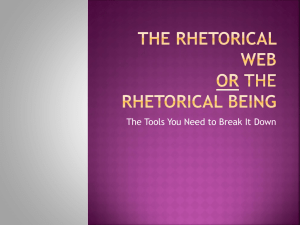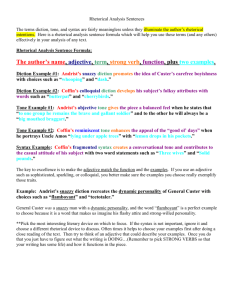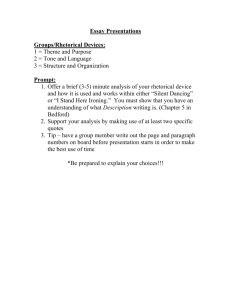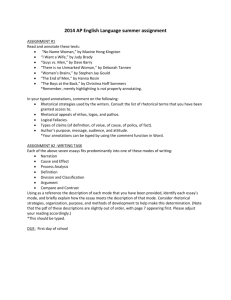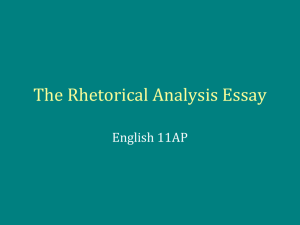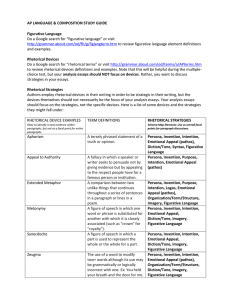How To Write a Rhetorical Analysis
advertisement
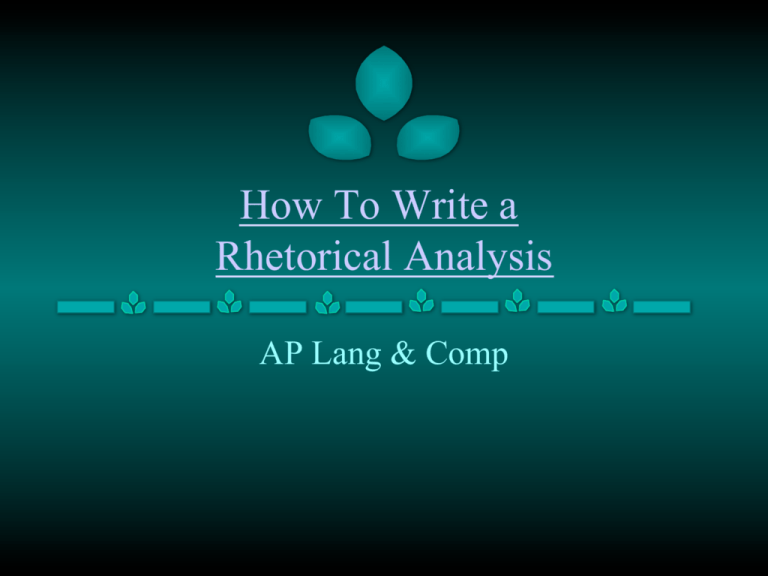
How To Write a Rhetorical Analysis AP Lang & Comp What are Rhetorical Techniques? • The effective use of words to persuade or influence. • Includes ethos, logos and pathos. • Includes tone, diction, details, imagery, figurative language, humor, syntax, etc, etc, etc. • Anything used to deliberately create effect. What is a Rhetorical Analysis? • Writing that separates the content (what the passage is about) from the methods (rhetorical strategies) used to successfully convey that content. • Prompt offers an effect; answer should identify and discuss rhetorical techniques used to create the effect. • Rhetorical Analysis = Why, How, So What • WHY = Are the choices effective and appropriate for the intended audience? • HOW = What techniques doe the writer choose to present the material? • SO WHAT = What is accomplished or created? • If you don t do this, you don t have analysis!! How do I Write a Rhetorical Analysis? • Analyze the prompt to determine what kind of analysis and what effect to address. • Understand the passage! • Deal with hidden questions, such as: What IS the effect? Answer these in the first body paragraph. • Given the time, select three techniques to discuss. Keep in mind the type of essay presented by the passage and look for typical techniques for that rhetorical mode. • Compose a thesis that states BOTH the effect AND the techniques. • Be sure to avoid the trap of explaining meaning; no AP essay question will ask you what a passage means. • Focus on HOW a technique creates the given effect. • Rule of thumb: more than HALF your essay should be commentary. ** Write a three sentence summary of these notes. ** How do I Write a Thesis for a Rhetorical Analysis? • The author s name • plus an adjective (sophisticated, carefully crafted, flashy, inventive) • plus the rhetoric strategies (three specific rhetorical strategies used as topics of body paragraphs) • plus a strong verb (demonstrates, creates, emphasizes, generates, fulfills) • plus the function (what the rhetoric does for the piece) Example: Douglass s sophisticated use of diction, imagery and figurative language creates his unfavorable attitude towards slavery. Use the SAME FORMULA to create your analysis… Diction: • Author s name • plus adjective • plus the term diction • plus a strong verb • plus the function • plus examples from text. Example: Andrist s snazzy diction recreates the dynamic personality of General Custer with choices such as flamboyant and teetotaler . Tone: • Author s name • plus an adjective (informal, light, impartial, simple) • plus the term tone • plus strong verb • plus the function • plus examples. Syntax: • Author s name • plus an adjective (short, simple, varied, repetitive, balanced) • plus the term syntax • plus the function • plus examples.




